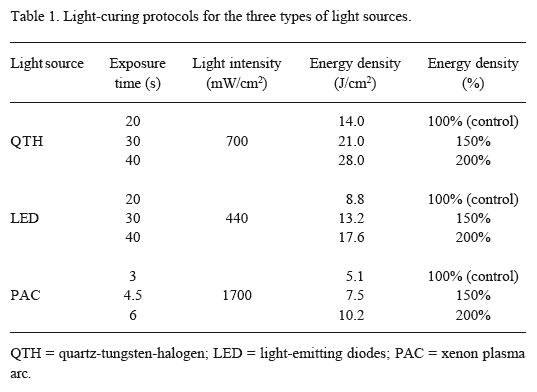The aim of this study was to evaluate the effect of the increase of energy density on Knoop hardness of Z250 and Esthet-X composite resins. Cylindrical cavities (3 mm in diameter X 3 mm in depth) were prepared on the buccal surface of 144 bovine incisors. The composite resins were bulk-inserted and polymerized using different light-curing units and times: conventional QTH (quartz-tungsten-halogen; 700 mW/cm²; 20 s, 30 s and 40 s); LED (light-emitting diode; 440 mW/cm²; 20 s, 30 s and 40 s); PAC (xenon plasma arc; 1700 mW/cm²; 3 s, 4.5 s and 6 s). The specimens were stored at 37°C for 24 h prior to sectioning for Knoop hardness assessment. Three measurements were obtained for each depth: top surface, 1 mm and 2 mm. Data were analyzed statistically by ANOVA and Tukey's test (p<0.05). Regardless of the light source or energy density, Knoop hardness of Z250 was statistically significant higher than that of Esthet-X (p<0.05). Specimens cured with PAC had lower hardness than those cured with QTH and LED (p<0.05). Higher Knoop hardness was obtained when the energy density was increased for LED and PAC (p<0.05). No statistically significant differences (p>0.05) were found for QTH. Knoop hardness values decreased with the increase of depth. The increase of energy density produced composites with higher Knoop hardness means using LED and PAC.
composite resin; energy density; Knoop hardness; light curing; light sources





